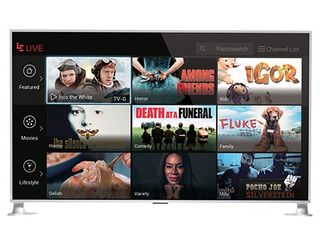LeEco Rolls the Dice on U.S. Market

On nov. 30 at the Grove, the popular L.A. shopping center, Chinese digital video and consumer electronics company LeEco gave American consumers their first hands-on look at its hardware, just a day before they first hit retailers such as Best Buy, Target and Amazon.
The company’s lineup of smartphones made up the majority of what LeEco had to show off at the relatively tiny booth, with a single TV set up in the corner. But the size of the setup belied the size of LeEco’s U.S. consumer electronics and content plans: With major content partnerships and a $2 billion deal to acquire Vizio (the nation’s No. 3 TV brand, after Samsung and LG) nearing final approval, LeEco aims to be a household name in America in short order.
“It should be a fairly big holiday season for us,” Greg Belloni, head of media for LeEco’s smart devices division, told NextTV at the booth. “We’ll definitely pay attention to our sales strategy here, and the reaction to that strategy will determine how we move forward.”
That sales strategy LeEco employs is the same one that made it such a success in China, when it started out purely as an online content company—sell hardware at cost or even at a loss, with the intent (indeed, the requirement) that consumers buy into the LeEco content ecosystem. In the U.S., new owners of a LeEco TV or smartphone will get a year-long, free membership to EcoPass, which includes exclusive access to entertainment (including the company’s own selection of more than 5,000 movies and 100,000 TV episodes), cloud services, a warranty and discounts on other LeEco products and services.
Standard content services such as Netflix, Showtime and Pandora are also included, and the company announced Nov. 29 that it’s partnered with AT&T to offer new smartphone and TV owners six free months of DirecTV Now, the new service that offers 100-plus channels for $35 per month. Owners of LeEco’s high-end uMax85 4K TV will get a year’s subscription for free.
“DirecTV Now has the entertainment experience you love, with more TV freedom designed for your lifestyle,” said Brad Bentley, executive VP of marketing for AT&T Entertainment Group, in a statement. “We’re excited to offer LeEco customers a new way to enjoy the best in TV and video content.”
But since EcoPass is still in beta mode—and the company has yet to say how much it will cost once the free trials run out—Belloni admitted there’s been “mixed” reactions to the LeEco content ecosystem, which will also work using a series of company credits.
Broadcasting & Cable Newsletter
The smarter way to stay on top of broadcasting and cable industry. Sign up below
And the company is still trying to decide what to do with the Vizio brand—leave it alone and operate it separately under the LeEco umbrella? Incorporate it into LeEco’s own name brand? A lot of that may be decided in the next month, as the company keeps an eye on how its TVs perform at retail. And they do have some early indications that those TVs will do well, with direct sales via the company’s website showing consumers are interested, Belloni added. The MSRP price for its 4K sets aren’t outrageous; its Super4 X series of TVs run from $649 (43 inches) to $1,399 (65 inches), and each can be had for $200 less if consumers sign up for LeEco’s rewards program. The sets handle high dynamic range, and include 3GB of RAM and 32GB of storage.
Much like the booth in L.A., LeEco is going to be understated at next month’s Consumer Electronics Show (CES) in Las Vegas, skipping the massive Sony- and Samsung-like mega- booths in the main hall for a smaller spot in the North Hall of the Las Vegas Convention Center. But being understated so far in the U.S. doesn’t mean the company isn’t looking to be big in American households. “Entry-level prices and drawing consumers with our technology is what the plan is,” Belloni said.
